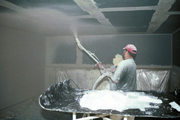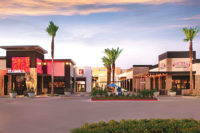
Some contractors view quick turnaround as a red flag for shoddy construction. Others see speedy work well beyond their scope given limited resources and manpower. Few are happy to take their time. But is it desirable to chase after volume along with good construction? For those that believe both quality work and more area can be maintained-in this case plaster finishing-under a short period, alternatives are afoot.
Consider the progress of S. Terry Plastering & Construction Inc. Because of a name that has lasted more than 50 years within the business, this Rockford, Ill., troupe has found its solution to the finishing process in new construction from general contractors, Three Hammer, also of Rockford.
Multifaceted in wall and ceiling construction, S. Terry offers services in EIFS, metal and steel framing, plastering and decorative remodeling, among other ideas and skills. Its energies as of late have been honing finishing skills with the aid of spray pump systems and a "secret" mixing method. Believing they have it down to a science, the company has been hanging drywall and spraying roughly 9,000 square feet of veneer plastering per day in newly constructed single-family homes. The objective is volume and the cause is mass (profit).
The assembly line
Both companies, Three Hammer and S. Terry, have a history that dates back through three generations of a compatible working relationship. Because S. Terry has been contracted for the general contractor's work (more than 90 percent of the market), real estate is being sold quicker. Not unlike an open auction, families view homes before construction is complete and generally bids for purchase are placed before the drywall is hung. With S. Terry's crew, these homes can be finished in three days and ready well before counterbids and negotiation battles begin."Usually, once they're in the ground, they're sold well before they're plastered," says Scott Howell, project manager of Three Hammer. "Roughly 80 percent of these homes have been purchased this way."
"The developer had called me to pick up some of the overflow work," says Steve Terry, president of S. Terry. "After we started the overflow, I could see there was a good opportunity (for the amount of homes Three Hammer had available to do) for profit."
The average swat team of five or six plasterers applying basecoats, veneer coat, et al, by hand was not feasible for the turnaround demanded from Three Hammer. A better system for keeping with the volume needed to be implemented.
"We have approximately 200 homes under construction at any given time for a consumer to come in from a dig stage to a finish stage," says Glenn Hammock, president of Three Hammers. "Our average square foot home is roughly 1,900 ranging from 1,200 to 5,000. Steve (Terry) is in five different counties around the area-he's all over the place."
"The availability of plastering is limited in this area," says Terry. "Plus, we're looking for alternative ways for applying the work. I called a manufacturer and asked if it could customize a mix in the plaster so it would be easier to spray, and the reply was, 'Are you nuts? This is a dying trade.'"
The amount of homes that needed to be finished called for a system that would not replace the rhythm of workers, but would serve as an accessory to their skills. Many methods of trial and error were practiced. It was around this time that S. Terry began looking into spraying machines.
These pumps basically cut to the chase with finish on top of the Kal base the company was using on the new homes. More and more, drywall contractors tackling a bulk amount of plastering are using these machines to both abide to the Level 5 finish, and because of the ease of use and time-saving capabilities.
"I searched and thought I found a machine manufactured by Turbosol, a machine McDonald Equipment sells," says Terry. "We drove up to Michigan to try the machine out. We took 10 to 15 bags to go, ran it through the machine on walls in a warehouse. After experimenting with the system for a couple months, we moved to a smaller machine called Poli T. We got one down here and used it on a few of these homes. After a couple months of a learning curve, we are able to finish a lot of square footage per day with it."
Sweet smell of success
Subcontractors and others interested in using pumps should note a couple of troubleshooting tips to ensure success. First, the manpower is needed along with the machine. Several workers must work in synchronicity to help spread the spray around and for an even spray without much waste. Another problem is with the basecoats. The more the machine is pumped, the more the material gets compressed and tends to set faster. The company slaved over the science of getting the mud to slide away without the pump compressing the material."On the first day when we do the basecoat, we'll go over and set up the house," says Terry. "We hang the drywall, do corner beads, tape and apply the first coat of veneer coat plaster-in 51/2 hours with 10 plasterers and two laborers. By the third day, all we have is clean up; same number of employees. We've increased our volume by thirds."
Terry reports the hardest aspect of the job is controlling the machine. The personnel that uses the spray has to contend with the spray and the nozzle, which is why they get a second laborer in there to help control the process. To their luxury, the other plasterers are enthralled with advantages of the new system.
"They're enjoying it because it's a lot easier for them physically, both on the basecoat and the finish coat processes," says Terry. "This system eliminates going back and forth to the mud board-they've simply had to smooth down the spray. For the finish coat, they have to run an angle tool for the angles and either trowel to a smooth finish bor texture as desired.
"There needs to be a change to entice the younger generation of trades, that was my reasoning for using the spray machine," he continues. They need to build these homes in a month. With the rising costs of gypsum there needs to be a way to cut prices."
Almost 50 years ago, when the Kal Kote product was introduced in the late '50s, the company was then called Terry Bros. Plastering, a family business that trowelled its name to the top. In 2002, with fresh ideas next to the hawk and trowel, S. Terry views innovation and progression its way of reestablishing themselves as the reliable and trusted service its name has labored to produce since 1949. With good business practices, the commitment to utilize the plaster line and devotion to quality, there is no doubt the company will remain above the ground and on the walls.
"We've been associated with S. Terry Bros. when it was Steve's dad's business," says Hammock. "Their detail on quality is something that is hard to find and Steve seems to keep it there."


